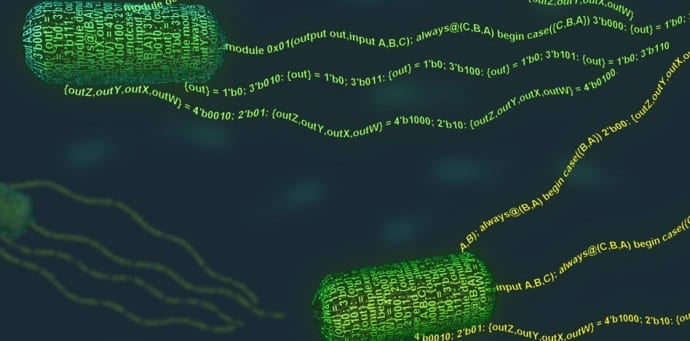A new programming language gives researchers the tools to create biological circuits inside living cells.
A tool similar to computer code now lets you design DNA circuits inside living cells by just using a simple symbolic language. Currently, the circuits are simple, but more advanced versions could reprogram cells to detect cancer and then produce a drug to kill it on the spot.
The tool uses an existing language called Verilog, which is used by chip designers to design electronic circuits. The idea is to make programming cells more like programming a computer. “We take the same approach as for designing an electronic chip,” says Chris Voigt of Massachusetts Institute of Technology (MIT). “Every step in the process is the same – it’s just that instead of mapping the circuit to silicon, it’s mapped to DNA.”
By engineering DNA ‘circuits’ – which imitate electronic circuits – bioengineers in the US were able to rewrite the code of bacteria, changing their functions to environmental cues.
Just like writing computer software, scientists were able to code new functions for cells using a text-based programming language which is transferred to the cell’s DNA.
“It is literally a programming language for bacteria,’ said Voigt. “You use a text-based language, just like you’re programming a computer.
“Then you take that text and you compile it and it turns it into a DNA sequence that you put into the cell, and the circuit runs inside the cell.”
Synthetic biology aims to make it possible to treat cells as machines that can be engineered and programmed. By altering a microbe’s native DNA, it can be made to perform a specific task, such as producing a drug or changing colour to detect a virus in blood. Off-the-shelf genetic parts that can be swapped in and out make this easier, but it is still a painstaking process.
That’s where Verilog comes in. Verilog is a symbolic language that lets you specify the function of an electronic circuit in shorthand – without having to worry about the underlying hardware – and then convert it into a detailed design automatically. Voigt’s team understood they could do the same with DNA circuits.
Called Cello, their system takes a Verilog design and changes it into a DNA wiring diagram. This is put in to a machine that creates a strand of DNA that encodes the stated function. The DNA can then be inserted into a microbe.
Voigt and colleagues at Boston University and the National Institute of Standards and Technology have built biological circuits capable of measuring light, temperature, acidity, and other environmental conditions such as oxygen level or glucose. They have designed and tested 60 circuits – 45 worked perfectly the first time they were tried.
One was the largest biological circuit ever built, with seven logic gates and strands of DNA 12,000 units long.
“Cello will allow synthetic biologists to concentrate more on what they want their microbes to do, and less on how to get them to do it,” says Matthew Bennett at Rice University in Houston, Texas. It also lowers the barrier for entry for those without expertise in biology, he says.
Scientists now have a standard method for shaping these circuits with the new programming language, which means they can design them quickly and then test them as soon as possible.
Voigt said he wants to make the language available on the Web for others to use.
The team reported their research in the journal Science.

Holy crap, that is so awesome, and it can create more jobs as well as potentially cure tons of diseases